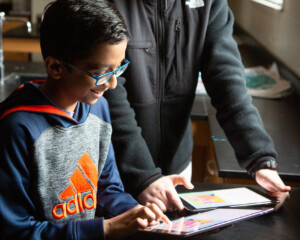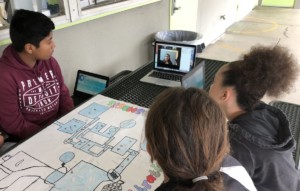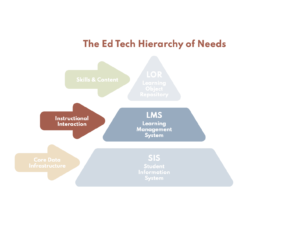The Generational Gap in EdTech Perception With Gen Z

By Dayton Uttinger
My ten-year-old uncle is a unique position, and not just because he is younger than his nieces. His parents are Baby Boomers, and my sister and I are Millennials. He has influences from every generation, and we’re all trying to impart our wisdom.
All the same, he has adapted many of the characteristics of a Gen Z member, including a dependence on technology. He has never experienced a world without it, so there is no inappropriate place to pull out his phone or tablet.
I understand this obsession with technology; I’m only one step away from it myself. However, Gen Z’s relationship with tech differs from any before it, and it has become deeply ingrained in all aspects of their lives, especially when it comes to school. While some educators maintain that technology is more of a distraction than anything else, that is unlikely to halt tech’s rapid encroachment of schooling.
My own teachers tirelessly attempted to prevent students texting–now schools have Bring Your Own Device policies. We recognize that today’s students feel naked without technology. They see a blank worksheet and wonder why it’s printed when they could just access it on their tablet. Teachers stuck in the past are fighting a losing battle, and those who accept tech are now attempting to utilize the same devices that they were once banning.
However, these efforts produce little to no result. According to the Organization for Economic Cooperation and Development, increased use of technology can actually hurt students’ performance. So how do educators balance the increasing demand for tech in classrooms with these findings? Clearly, we’re not implementing technology to its full capacity. The problem is less the specific strategies that educators are using; the issue is how educators (from all generations) are approaching teaching students who view tech fundamentally differently than we do.
How We See EdTech
Look, I’m a Millennial, but I still lump myself in the same category as Gen X and Baby Boomers here. I might be more adept at operating technology and use it more frequently, but we all see technology as a tool, just like a worksheet or a textbook. It is a resource that we can use, effectively or not. We create different technologies to solve a problem and work for us.
While we’ve all become more and more reliant on technology as time goes by, perhaps it’s the fact that we can remember a time when it didn’t consume everything that alters our perspective. At the younger end of the Millennial spectrum, this line begins to blur, fading into Gen Z.
How They See EdTech
For those who grew up on social media and constant web connection, technology is not a tool–at least not the way we think of it. It is a non-negotiable medium, and only considered a tool in the loosest sense. It is always present, accessible and desirable. Technology does not work for Gen Z–it works right along next to them.
Furthermore, they see EdTech as a downgrade from their personal access. They are already underwhelmed with technology at their college or university, so imagine what public K-12 students think of their teachers pushing Prezis and faltering Wi-Fi connections. Why should they read and discuss this article you assigned when they can learn everything they need to know (and more) through a quick Google search on their phone? Gen Z sees edtech as below their standard. They don’t take it seriously. Why should they? Their smartphone can already do everything a traditional classroom does.
So, What Needs to Change?
Teachers can’t see technology as merely optional. That’s not to say that every assignment must include some state of the art tech, but allow students to use it. However, our view of technology as a tool complicates the matter further. Teachers simply take techniques that we’ve always had, like visual aids and demonstrations, and modernize them. But using PowerPoints or virtual dissections is not a revolution in education, and it doesn’t utilize technology to its potential.
Students see technology as ever-present and fluid, and it’s time that educators treated as such. Instead of emphasizing rote tasks, tech should be used to connect, to collaborate and to be critical. That’s how students already see it. When educators use technology for drills or rote memorization, there is no benefit when compared to decades-antiquated techniques. Instead, technology needs to be integrated naturally and promote creativity and integration. This means less online worksheets and more online creation and multimedia approaches.
It also means more expenses, especially for schools filled with low-income students. While schools can stretch their tech budget by following a few simple tips, instructor creativity has always been a necessity. Not every student will have a device, but the vast majority will be familiar with how to operate one. They will have to use them in the professional world, so school might as well reflect that.
Right now, technology in the classroom is still sometimes being treated as some sort of revolution. It’s not. Much like how laptops are accepted in college lecture halls, we can’t fight tablet and smartphone integration. Yes, students are distracted, just like they would be if teachers somehow managed to remove tech from the classroom completely. Educators can no longer afford to wonder if tech has a place in the classroom–it’s already there to stay. So the only issue is how to best utilize it, which is admittedly trickier than it sounds. Instead of forcing it into already existing curricula, educators can integrate tech naturally.
Even though we are still wrapping our heads around technology’s domination of our world, students cannot imagine anything different, so let’s get the classroom caught up to the rest of the world.
For more, see:
- 7 Game Changer EdTech Tools to Personalize Your Classroom
- Welcome to the Unclassroom
- Selfie Expression in the Classroom
Dayton Uttinger is a freelance education technology writer in Boise, ID. Follow her on Twitter: @dkai117.




0 Comments
Leave a Comment
Your email address will not be published. All fields are required.